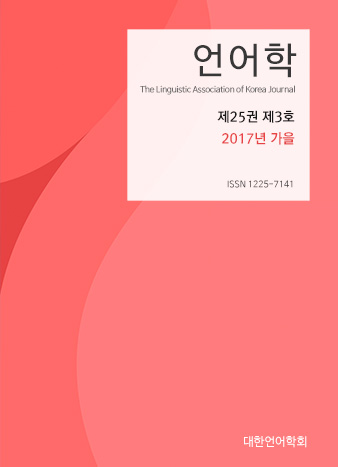대한언어학회 전자저널

25권 3호 (2017년 9월)
- English sentential subject extraposition: Toward a 'how far' and 'why' view
-
Seung Han Lee & Chul Joo Uhm
Pages : 69-91
Abstract
Lee, Seung Han & Uhm, Chul Joo. (2017). English sentential subject extraposition: Toward a 'how far' and 'why' view. The Linguistic Association of Korea Journal, 25(3), 69-91. English sentential subject extraposition is a marked feature, but it is quite a systematic structure. This study aims to provide an extraposition occurrence environment and a plausible trigger for the extraposition of a sentential subject. To this end, we first identify a total of 414 examples of COCA corpus, and then discuss their predicates as well as sentential types. An adjectival predicate (52.2%) is frequently employed without a strict semantic restriction, whereas that-clause (55.8%) and to-infinitival clause (35.5%) are mostly extraposed at the sentence-final position. From this corpus data, we suggest that the extraposition occurs across no more than the first complement of a head verb if and only if the complement is not a clause. In addition, the extraposition is assumed to be triggered in order to maximize focus effect (i.e., degree of pitch increase) rather than its grammatical weight, information structure, or BNFC constraint. The essence of the extraposition can be interpreted without solely grounds of the complex syntactic constituents or the discourse-new/old structures. In other words, in order to achieve a speaker's desired result to put an emphasis on a main predicate, he or she employs the rise of pitch on the main predicate, thereby extraposing a sentential subject.
Keywords
# SSE # extraposition # focus effect # Focus Effect Principle
References
- Arnold, J. E., Losongco, A., Wasow, T., & Ginstrom, R. (2000). Heaviness vs. newness: The effects of structural complexity and discourse status on constituent ordering. Language, 76(1), 28-55.
- Bouma, G. (1996). Extraposition as a nonlocal dependency. In Proceedings of Formal Grammar 96. 1-14.
- Collins, P. (1994). Extraposition in English. Functions of Language, 1(1), 7-24.
- Chomsky, N. (1981). Lectures on government and binding. Dordrecht: Foris.
- Davies, W. D., & Dubinsky, S. (2009). On the existence (and distribution) of sentential subjects. In D. B Gerdts, J. C. Moore & M. Polinksy (Eds.), Hypothesis A/hypothesis B: Linguistic Explorations in Honor of David M. Perlmutter (pp. 111-128). Cambridge, MA: MIT Press.
- Francis, E. J., & Michaelis, L. A. (2017). When relative clause extraposition is the right choice, it’s easier. Language and Cognition, 9(2), 332-370.
- Groat, E. M. (1995). English expletives: A minimalist approach. Linguistic Inquiry, 26(2), 354-365.
- Hawkins, J. A. (2004). Efficiency and complexity in grammars. Oxford: Oxford University Press.
- Huddleston, R., & Pullum, G. K. (2002). The Cambridge grammar of the English language. Cambridge: Cambridge University Press.
- Kaltenböck, G. (2003). On the syntactic and semantic status of anticipatory it. English Language and Linguistics, 7(2), 235-255.
- Kaltenböck, G. (2004). It-extraposition and non-extraposition in English: A study of syntax in spoken and written texts. Braumüller: Purdue University Press.
- Kim, J. B. (2005a). Subject and object extraposition in English: Corpus findings and a constraint-based approach. Studies in Generative Grammar, 15(2), 145-164.
- Kim, J. B. (2005b). English object extraposition and constraint satisfaction. Language Research, 41(4), 855-880.
- Kim, J. B. (2006). Minimal recursion semantics: An application into Korean. The Linguistic Association of Korea Journal, 14(2), 59-85.
- Kim, J. B. (2008). Grammatical interfaces in English object extraposition. Linguistic Research, 25(3), 117-131.
- Kim, J. B., & Lim, K. S. (2008). An HPSG analysis on the unbounded dependency constructions in Chamorro. The Linguistic Association of Korea Journal, 16(4), 187-211.
- Kim, J. B., & Sells, P. (2008). English syntax: An introduction. Stanford: CSLI Publications.
- Kim, J. B. (2012). On the syntax of the it-cleft construction: A construction-based perspective. Linguistic Research, 29(1), 45-68.
- Kuno, S. (1987). Functional syntax: Anaphora, discourse and empathy. Chicago: The University of Chicago Press.
- Larsson, T. (2016). The introductory it pattern: Variability explored in learner and expert writing. Journal of English for Academic Purposes, 22, 64-79.
- Lee, N. G. (2015). A data driven learning approch to English extraposition constructions. The Linguistic Association of Korea Journal, 23(3), 69-83.
- Lee, S. H., & Uhm, C. J. (2017). English relative clause extraposition: A corpus-based approach. Studies in Linguistics, 42, 143-163.
- Lee, S. H. (2017). Factors at play in extraposing English relative clauses. Unpublished doctoral dissertation, Chonnam National University.
- Miller, P. (2001). Discourse constraints on (non) extraposition from subject in English. Linguistics, 39(4), 683-702.
- Quirk, R., Greenbaum, S., Leech, G., & Svartvik. J. (1985). A comprehensive grammar of the English literature. London: Longman.
- Reeve, M. (2011). The syntactic structure of English clefts. Lingua, 121(2), 142-171.
- Sag, I. A., Wasow, T., & Bender, E. M. (2003). Syntactic theory: A formal introduction. Stanford: CSLI Publications.
- Smolka, V. (2005). Non-extraposed subject clauses. In Theory and Practice in English Studies 3: Proceedings from the Eighth Conference of British, American and Canadian Studies. 137-143. Brno: Masarykova Univerzita.
- Uhm, C. J. (1998). Communication strategies in interaction between Korean EFL learners. The Linguistic Association of Korea Journal, 6(1), 487-502.
- Uhm, C. J. (2000). Investigating the empirical aspects of communication strategies. The Linguistic Association of Korea Journal, 8(1), 353-377.
- Wasow, T. (2002). Postverbal behavior. Stanford: CSLI Publications.
- Zhang, G. (2015). It is suggested that… or it is better to…? Forms and meanings of subject it-extraposition in academic and popular writing. Journal of English for Academic Purposes, 20, 1-13.